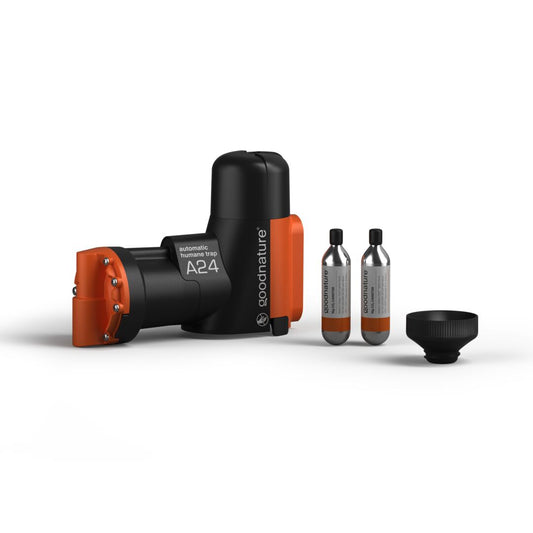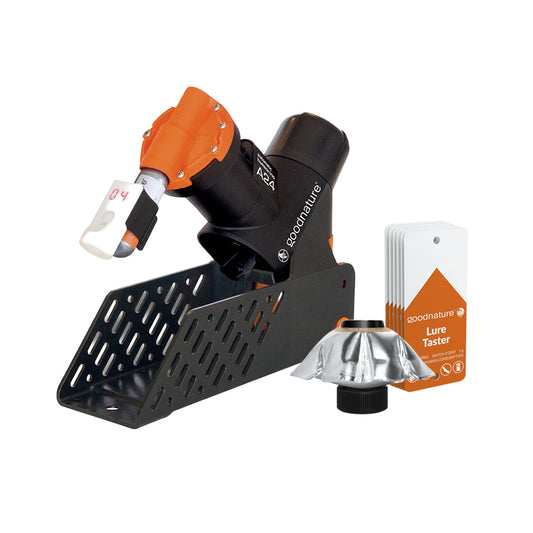
If you've found yourself with a rat problem then you're probably heavily focused on getting rid of them. You probably haven't found yourself slowly mulling over what the average day is like for a rat. However, oftentimes this is the best way to deal with a rodent problem. Thinking about how, and what, a rat eats can help you get rid of them.
To understand what might catch a rat's attention we first need to look at what these rodents eat in the wild. By understanding the ideal rat diet, you can create attractive lures and help increase your rat trap efficacy.
Similar Tastes for Similar Environments
Rats and humans have been linked together through countless generations. Part of this is due to the fact that rats are small and clever animals who can easily sneak into human quarters. Rats, just like humans, are omnivores, meaning they can eat almost all biological material.
The main difference between a rat in the wild and one in your home is their options. In the wild a rat needs to work for their meals. This creates a very different situation than a rat in your home who can rummage around in the trash. Before moving on to specific dietary choices it's important to really consider how much work goes into finding food. Imagine how you'd structure your diet if you needed to actually hunt or forage for every meal. What foods would you need the most in order to live your life? Which foods might satisfy both nutritional needs and your tastes?

The Best Food Is What’s Available
It's important to remember that rats live in a wide variety of different habitats. Combined with the fact that they're omnivorous this means that they can have an extremely varied diet. For example, a wild rat in North America is going to eat quite differently than one in Australia.
But with that in mind we can look at shared behavior to determine an average rat's diet. In particular, it's important to remember that rats are scavengers. They're typically interested in covering a wide area to eat a larger variety of foods. Along the way they'll often nibble on anything they don't recognize.
This nibbling behavior isn't a sign of picky eating. Instead, eating a small amount of a new food helps rats determine if it's safe. If a rat nibbles on something new and then feels sick they will know to avoid it in the future. This is also one of the reasons why rodent control can lose effectiveness over time. A rat might notice the correlation between rat lure and the loss of his colony members.

Plants
Now that we've looked at how a rat eats we can examine some specific examples. A rat's tastes aren't too different from that of a human. So you can begin by thinking about the environment around you. What wild plants would catch your attention? Fruits and berries will be at the top of most people's lists. After all, even people in cities will often have the chance to grab some wild berries during the summer.
Vegetables are also an important part of everyone's diet. But wild, edible, vegetables in most areas aren't nearly as common as fruits and berries. What's more, few people would deny that fruits and berries taste better than carrots or kale. The average rat would agree to that sentiment.
Fruits and berries have another trait that rats love as much as the taste. Fruits and berries won't run away from a rat. As such they don't have to invest many calories into tracking down the sugary delights. Most humans would rather start with dessert before eating their vegetables. And rats are quite similar in that regard.

Meat
Meat is far more difficult for a rat to acquire. Most rats love the taste of meat. But they're also not going to get very much of it in their diet. They'll typically indulge in carrion if it hasn't been left to the elements too long. But in general a wild rat is typically going to get most of his meat from insects. It's only his more urban relatives who get to enjoy the occasional bite of a hamburger or hotdog.

Nuts and Seeds
The typical rat will value nuts and seeds as much as they do fruit. One of the big reasons comes down to protein. Rats like meat as a protein rich option. But most wild rats aren't in an environment where they have easy access to it.
A rat would much rather forage for food than try to hunt prey animals. This can often provide them with ample calories when they're eating fruits and berries. Likewise, greenery will provide rats with a wide variety of vitamins. But protein's harder to scavenge for. Thankfully for the rats, they have one fantastic source of plant based protein in the form of nuts and seeds.
Some larger nuts can prove a little harder for rats to handle. But for the most part a rat will happily gnaw away at just about any type of nut. Seeds are often even better since they're more suitable for a rat's smaller grip.

Eggs
There's one additional source of protein that most rats absolutely love - eggs. Eggs are typically pretty large when compared to a rat. But rats are quite capable of eating even the largest eggs. In fact, farmers sometimes see rats rolling chicken eggs out to their homes. In nature a rat is more likely to stumble onto the much smaller eggs of wild birds. But they will be just as adamant about getting that meal.
The reason once again comes down to nutrition. An egg has everything a developing bird needs to thrive. Likewise, it provides everything that other living beings would need as well. Rats find an ample source of protein, many vitamins and minerals and calories in any given egg. What's more, they typically aren't risking injury when they dash out to snack on an egg. The amount of calories needed to get an egg is minuscule compared to trying to hunt a small animal for meat.
Developing a Strategy Around a Rat’s Natural Diet
The wild rat diet is essentially centered around maximizing nutrition while minimizing both risk and energy expenditure. Applying that principle to rodent control might seem difficult at first. However, it simply comes down to selecting lure options which would appeal to a rat's preferences. Rats like to scavenge and search out new sources of food. So placing more traps in different parts of your home will often produce better results than a single trap.
On top of this rats like sugary foods like fruits and berries. This can be replicated with sweeter bait options. And a rat's desire for fat and protein can often be found in different bait options as well.
In the end, getting a rat's attention is often best done by trying to meet the needs he'd express in the wild. This is usually best achieved by adding some variety into your rat control efforts. It can take a little extra work to create a more varied environment. Thankfully modern traps make it much easier to set everything up. In fact, if you start working on it now you'll probably have the problem taken care of far faster than you ever imagined possible.





